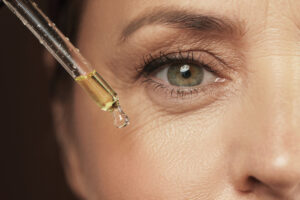Learn the early warning signs of having clogged arteries!
Having clogged arteries can mean that the blood supply to different body areas get cut off. And the location of the clog dictates the signs and symptoms. Arteries are responsible for carrying blood that’s full of nutrients and oxygen to every cell in a person’s body.
When this supply is cut off for any reason whatsoever, you’ll probably experience certain symptoms, which can vary in severity. Some organs and tissues can resist a drop in blood supply and regenerate, while others will simply die off.
But we get that it can all sound a bit confusing. So Golden Years Bliss has decided to simplify it! Continue reading about the 8 symptoms you might notice if you have clogged arteries.

Chest Pain
That squeezing sensation in your chest isn’t something to simply brush off and ignore. Chest pain, a.k.a. angina, is usually the first red flag of having clogged arteries. It happens when your heart muscle is deficient in oxygen-rich blood because of narrowed coronary arteries.
This ache can feel like squeezing, pressure, fullness, or pain in your chest. It might even radiate to your neck, jaw, arms, or back. The pain generally occurs during emotional stress or physical activity and eases with rest. Don’t dismiss it.
Angina is your heart’s way of telling you it’s struggling. If you seem to be experiencing these symptoms, especially if they’re new or getting worse, it’s vital to seek medical attention immediately.
High Blood Pressure
Hypertension, or high blood pressure, is destructive because it typically has no symptoms. Yet, it’s also a major red flag for clogged arteries. As arteries constrict due to plaque buildup, your heart has to work harder to push blood through these narrowed passages.
This raised effort leads to higher pressure in your blood vessels. Regular blood pressure checks are vital because hypertension can damage your arteries further, forming a vicious cycle. If you always see numbers above 130/80 mmHg, it’s time to take action and visit your doctor.
Medication, lifestyle changes, or even a combination of both can help you manage your high blood pressure and protect your arteries from any further harm. Don’t let this silent threat go overlooked. Make sure you keep tabs on your numbers, and your heart will thank you for it.
Slow-Healing Wounds
Slow-healing wounds can be a telltale sign of clogged arteries. When arteries are restricted, it decreases blood flow throughout your body, and this includes your skin.
This reduced circulation can significantly slow down the healing process because your body is struggling to deliver the nutrients and oxygen necessary for restoration.
You might notice that scrapes, cuts, or other wounds stick around longer than usual or that minor injuries get infected rather quickly.
This is especially common in the lower extremities, where blood has to work against gravity. If you constantly wait for that Band-Aid to come off, consider whether your arteries may be playing a role in this.
Shortness of Breath
Have you been feeling winded after climbing up a flight of stairs that never seemed to bother you before? Shortness of breath could indicate that your lungs are crying out for help due to clogged arteries.
When your heart can’t pump enough blood because of blocked arteries, it could lead to fluid buildup in your lungs. This makes it harder for you to breathe, especially when performing physical activities.
You may notice that you’re struggling to catch your breath or you’re panting more than usual, even with minimal effort. It’s not just about being out of shape, either.
Persistent breathlessness, particularly when it’s a new symptom, could be a telltale sign that your heart is working overtime to counteract clogged arteries. It would help to talk to your doctor about these changes in your breathing patterns.

Sudden Vision Changes
While it’s easier to blame aging or eye strain, sudden vision changes are signs of clogged arteries. When the arteries that supply blood to your eyes become blocked or narrowed, it can lead to various vision problems.
You may experience dark spots, blurry vision, or even temporary vision loss in one eye. These indications usually come on suddenly and can be alarming. Some individuals describe it as a curtain coming down over their eyes.
While these episodes are typically brief, they should be addressed asap. They might be signs of a transient ischemic attack or “mini-stroke,” which can be a precursor to a more serious stroke.
If you detect any sudden changes in your vision, don’t look the other way. Seek medical attention immediately.
Ear Lobe Crease
Have you ever heard of the ear lobe crease? A sloping crease in your ear lobe could indicate clogged arteries. This phenomenon, also known as Frank’s sign, is a diagonal crease from the bottom of the ear opening to the border of the ear lobe.
Even though it may seem like a strange place to look for telltale signs of heart disease, quite a few studies have found a link between this crease and an increased chance of coronary artery disease.
The precise reason for this connection has yet to be fully understood, but it’s assumed to be connected to the breakdown of elastic tissue in the arteries and the ear lobes as we grow older.
If you notice this type of crease, especially if it appears on both ears, it may be worth mentioning to your physician.
Fingernail Changes
Have you noticed any changes in your fingernails recently? Believe it or not, your nails could be signaling clogged arteries. When arteries are blocked, it can influence blood flow to your extremities, including your fingers.
This decreased circulation can lead to various changes in your nails. You may notice that your nails have become more brittle, developed ridges, or changed color.
Some individuals even develop clubbing, which is when the nails curve downward, and your fingertips can become bulbous and rounded.
Even though changes in your nails can have many causes, constant alterations, especially when combined with other cardiovascular signs, are worth mentioning to your general physician.
Your fingernails could be more than a cosmetic concern. In fact, they could point toward some underlying arterial health issues.

Lightheadedness
Even though we all know that dizziness can have many causes, constant lightheadedness could be a telltale sign of clogged arteries. When arteries are restricted, it can decrease blood flow to your brain, which leads you to feel dizzy or lightheaded.
You may experience a sensation of unsteadiness, spinning, or feeling faint, particularly when standing up too fast or during physical activity. These manifestations can be especially concerning if they happen frequently or are accompanied by other symptoms of heart problems.
Lightheadedness can also be a warning sign of an irregular heartbeat, which can also be connected to clogged arteries.
If you reach for support often because you feel dizzy, it’s time to contact your doctor. Your balance issues could be tipping you off to a significant health concern.
Meanwhile, you can install some grab bars in the shower to avoid any accidents!
Now it’s your turn! Have you been experiencing any of these symptoms of clogged arteries? Let us know in the comments. And if you found this article helpful, we recommend you also read: 6 Shocking Things That Raise Your Blood Pressure




















One Response
Yes I have experienced some of these symptoms I had CT narrowing of arteries also Giant Cell Aretitis polymyalgia rheumatica amongst other ailments. Have not received any help yet except prednisilone